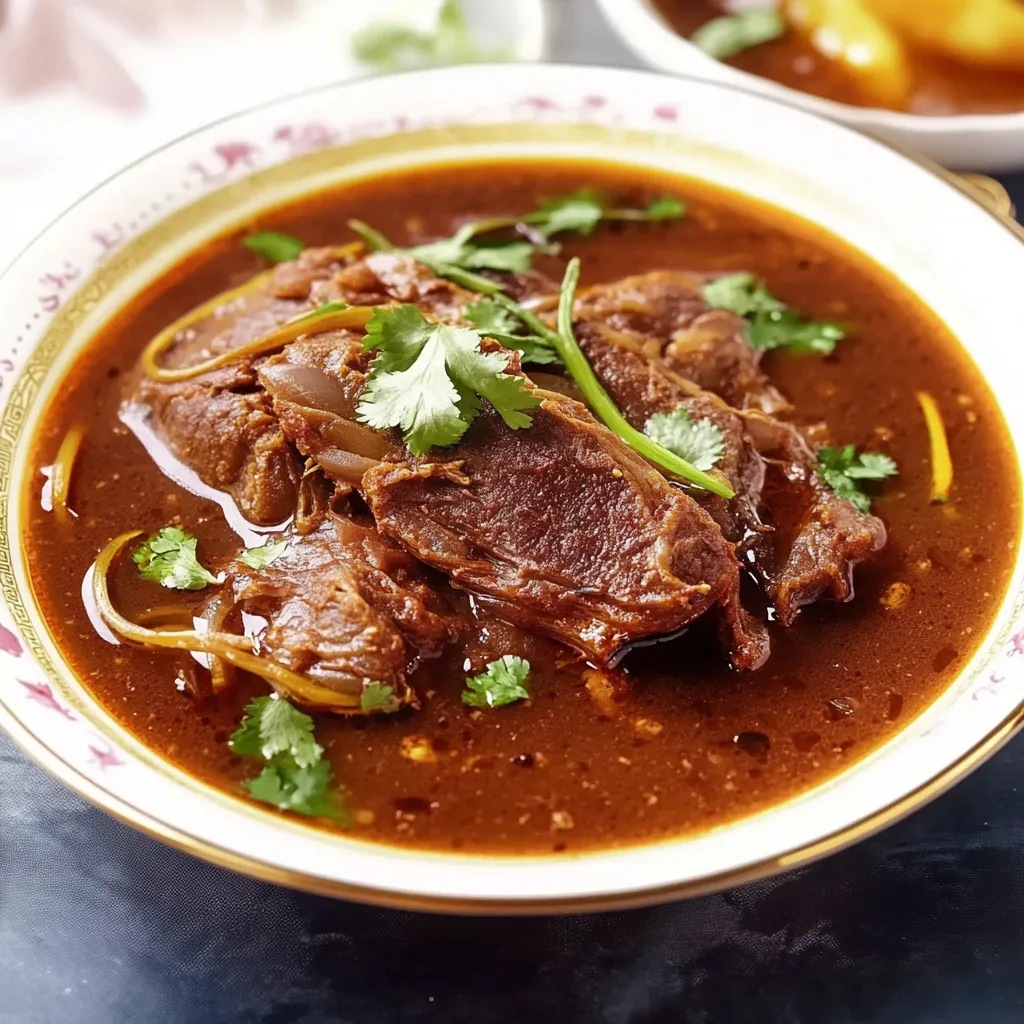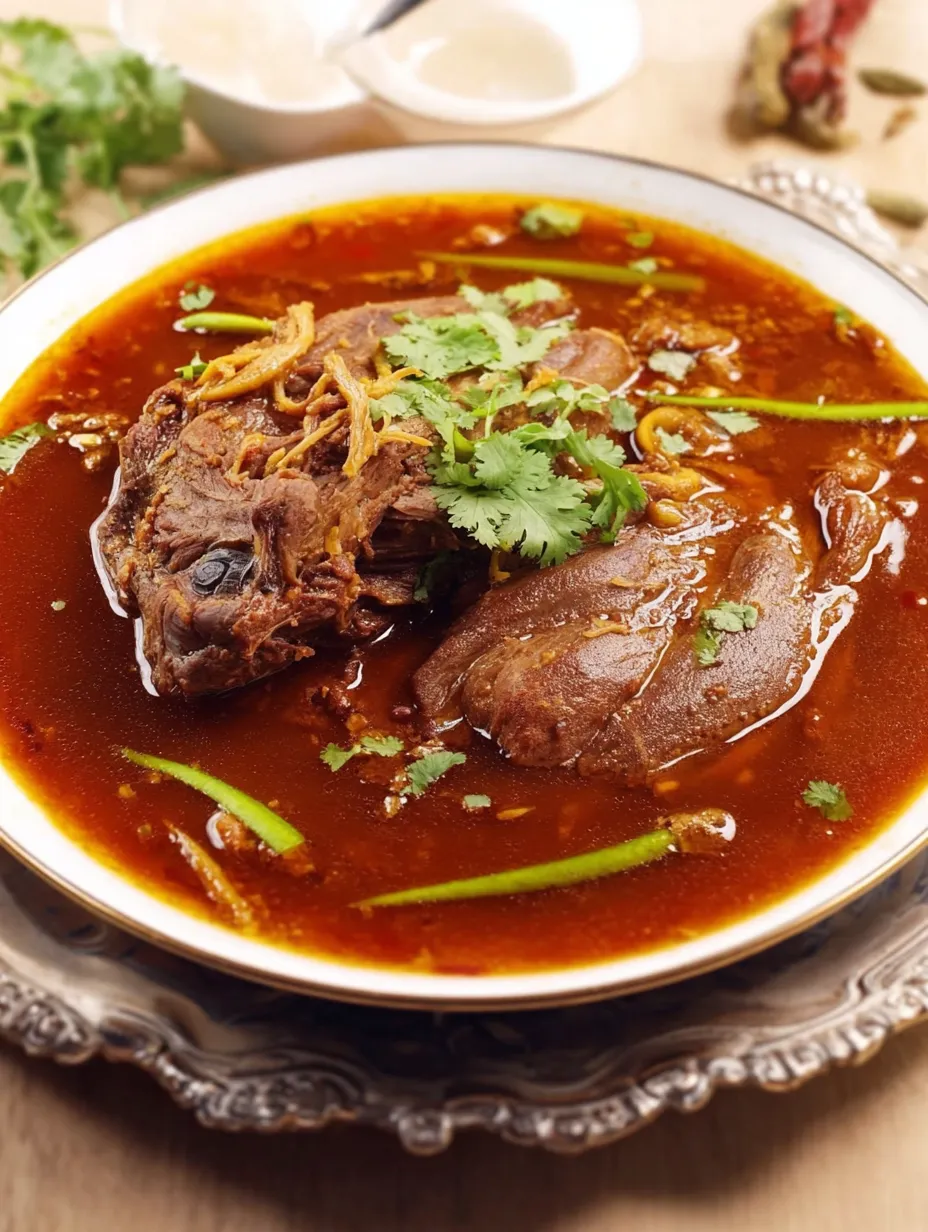 Pin it
Pin it
This deeply spiced Nihari is the kind of slow-cooked stew that turns a simple cut of beef into something magical and comforting. Rich in flavor and aroma it has always been my favorite weekend project and a centerpiece at family gatherings especially during chilly months when nothing warms the soul quite like it.
This was the first dish I tackled from my grandmother’s handwritten notes. Now any time I crave a Sunday spent in the kitchen filling the house with spices Nihari is at the top of my list.
Ingredients
- Whole spices: add depth and authentic aroma Use the freshest you have for best results
- Star anise: half a small one brings a licorice note and beautiful base flavor
- Bay leaves: two small ones create a slightly floral background
- Cinnamon stick: a one-inch piece provides sweet warmth
- Cloves and cardamom: essential for fragrance Green cardamom pods give a subtly citrus note
- Fennel seeds: lend sweetness and help balance the richness of beef
- Paprika powder: adds mild sweetness Opt for the brightest color you find
- Coriander and cumin powders: bring earthy complexity
- Turmeric: gives the iconic golden hue along with gentle earthiness
- Red chili powder or cayenne: for heat Adjust to your spice comfort
- Crushed red chili flakes: for another layer of flavor
- Black pepper powder: for peppery sharpness
- Garlic powder: a subtle backup if you like extra garlic
- Nutmeg: adds a tiny hint of warmth that rounds off the spices
- Nihari masala: either homemade or a good quality store-bought blend
- Canola oil or neutral oil: keeps the stew base smooth
- Ghee or butter: for deep rich undertones choose the best quality for aroma
- Onion: sliced thinly caramelizes for sweetness
- Fresh garlic and ginger: provide a classic punch absolutely use freshly crushed for maximum flavor
- Salt: essential for balance Consider kosher salt for easier control
- Durum atta flour: thickens and gives that distinctive silky texture look for stone-ground or fresher flour
- Water: use filtered if possible it makes a difference in clarity
- Beef shank meat: tough cuts work best due to long cooking buy the meatiest ones you can
- Garnishes: like garam masala crispy onions julienned ginger lemon cilantro and green chili add freshness and crunch
Step-by-Step Instructions
- Heat oil and ghee:
- Combine the oil and ghee in a heavy Dutch oven or deep pot Use medium heat and wait until the surface shimmers and smells nutty This blend gives both body and flavor to the stew
- Sauté whole spices and onions:
- Add star anise bay leaves cinnamon cloves and cardamom Let them crackle for one minute to release their fragrance Then stir in thinly sliced onions Cook slowly over medium-low heat stirring often for ten to fifteen minutes You want onions deeply golden soft and sweet because this forms your stew’s backbone
- Add garlic and ginger:
- Toss in freshly crushed garlic and ginger Stir constantly for half a minute until everything is fragrant and slightly sticky This step brings out their full brightness
- Brown the beef:
- Turn up the heat a notch and add beef shank cubes Sear on all sides until the color just changes and the meat looks sealed Browning here helps develop intensity in the finished broth
- Mix in ground spices and salt:
- Reduce the heat again Sprinkle in all ground spices and salt Stir quickly twenty to thirty seconds to gently toast the powders and unlock maximum aroma Be careful not to let spices burn
- Pour in water and simmer:
- Pour in measured water and increase heat until it boils Immediately lower the heat and cover for a gentle simmer If using beef shank keep it barely bubbling for six hours This long slow cooking creates tender meat and a broth with body
- Thicken with Atta flour:
- Scoop a cup of hot Nihari broth out let it cool then whisk with atta flour You want a smooth slurry Stir this back into the pot and cook uncovered for another twenty minutes The gravy should become glossy and thick Remove whole spices here if you wish
- Garnish and Serve:
- Ladle hot Nihari into bowls Top with freshly made garam masala crispy onions cilantro ginger and lemon Juice squeezed over each bowl is key Serve with naan or sheermal to soak up all the flavors
 Pin it
Pin it
The atta flour makes a noticeable difference in texture I learned quickly never to skip this step since it changes the mouthfeel and gives everything a luxurious finish One of my best memories is watching my aunt sneak extra ginger on top for the adults and it became my little tradition too
Storage Tips
Nihari keeps well in the fridge for up to four days and I think the taste improves day two to three Always cool completely before storing in a tightly sealed container To reheat use gentle heat and a little water to keep the gravy loose You can also freeze portions for up to two months just defrost overnight in the refrigerator and reheat slowly on the stove
Ingredient Substitutions
Beef shank can be replaced with lamb shank for a different but equally delicious depth You can use bone-in cuts for an even richer broth If durum atta flour is not available try plain whole wheat flour but add it slowly to avoid lumps Paprika can be swapped with Kashmiri chili powder for more color less heat
Serving Suggestions
Nihari truly shines with fresh naan or fluffy sheermal Those are great for dipping and soaking up the spicy broth A quick chopped salad of cucumber and onions on the side makes a nice fresh contrast Some even love Nihari ladled over a bed of steaming white rice with extra lemon squeezed on top
 Pin it
Pin it
Cultural Context
Nihari traces back to Mughal kitchens and is a weekend breakfast tradition in many households especially in cities like Lahore and Karachi The dish’s long simmering time was possibly designed for an overnight slow flame so that cooks could serve it at sunrise I love that sharing Nihari at home connects me to generations before me
Frequently Asked Questions
- → What cut of beef works best for nihari?
Beef shank is ideal due to its gelatinous texture, which becomes melt-in-your-mouth tender after long simmering.
- → Can I use store-bought nihari masala?
Yes, you can substitute homemade masala with store-bought. Adjust the amount based on your spice preference.
- → What can be used instead of atta flour?
If atta flour is unavailable, all-purpose flour can be used to thicken the stew, though the flavor may vary slightly.
- → How spicy is traditional nihari?
Nihari is moderately spicy, but you can adjust the level by increasing or reducing chili powder and flakes.
- → Which garnishes enhance nihari?
Garnishes like fried onions, ginger, lemon wedges, green chilies, and fresh cilantro add freshness and complexity.
- → Can nihari be made in a slow cooker?
Absolutely. Reduce water quantity and allow beef to simmer on low for extra tenderness and deep flavor infusion.
